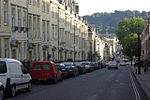Museum of East Asian Art, Bath

The Museum of East Asian Art or MEAA is in Bennett Street, Bath, Somerset, England. Just a few metres off The Circus in central Bath, the Museum of East Asian Art is situated in a restored Georgian house. Its collection includesceramics, jades, bronzes and bamboo carvings and more, from China, Japan, Korea and Southeast Asia. It is the only museum in the United Kingdom dedicated solely to arts and cultures of East and Southeast Asia.It houses a collection of almost 2,000 objects, ranging in date from c.5000 BCE to the present day. The Museum's collection started from the collection of Brian McElney, a retired solicitor who practised in Hong Kong for over 35 years, and has since been expanded.
Excerpt from the Wikipedia article Museum of East Asian Art, Bath (License: CC BY-SA 3.0, Authors, Images).Museum of East Asian Art, Bath
Bennett Street, Bath Walcot
Geographical coordinates (GPS) Address Website External links Nearby Places Show on map
Geographical coordinates (GPS)
| Latitude | Longitude |
|---|---|
| N 51.3864 ° | E -2.3633 ° |
Address
Museum of East Asian Art
Bennett Street 12
BA1 2QJ Bath, Walcot
England, United Kingdom
Open on Google Maps










